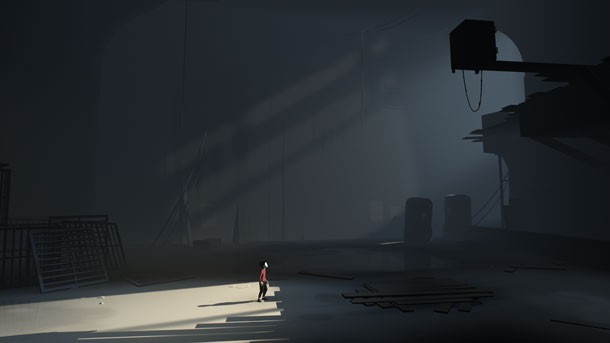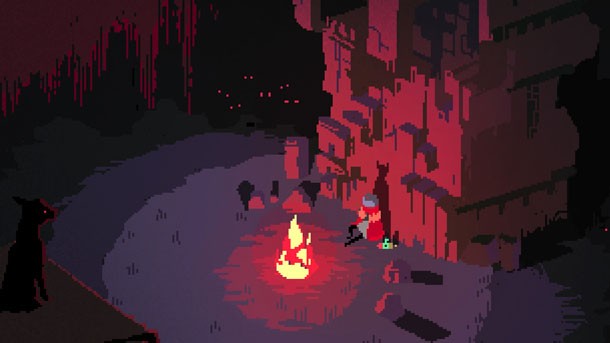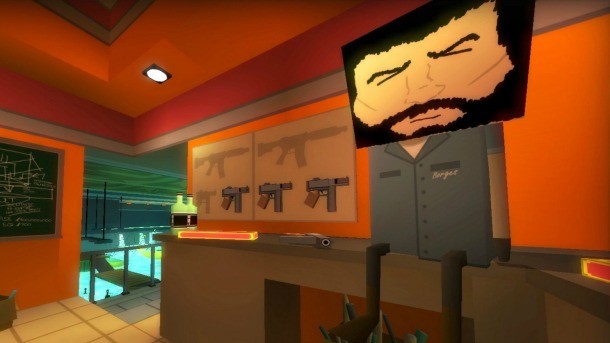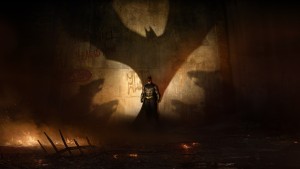Please support Game Informer. Print magazine subscriptions are less than $2 per issue
How Developers Are Creatively Building Silent Interactive Stories

This article originally appeared in Game Informer issue #285.
Mindless humanoids march in single file, shoulders hunched forward and heads bowed down. A young boy sneaks into this systemic traffic of beings, mimicking the others’ movements while an overhead spotlight watches his every move. Without dialogue or text to contextualize the situation, you begin to wonder: What brought him here? Why is he being hunted? Is he running away from something, or towards it?
Playdead’s Inside tells an ambiguous story about an oppressive, Orwellian world. Speaking volumes without a single word, the narrative creates an emotional connection through its nightmarish atmosphere and leaves the rest up for interpretation. A loneliness creeps over you as you move from one rundown environment to the next; and it’s especially effective because of its perpetual silence.
Inside is far from alone in this feat. Several game developers are creatively ditching words, giving their games a more ambiguous story, or one that isn’t spoon-fed to the player. It can increase the player’s engagement as they try to piece together a story, or it can create a more atmospheric experience. Games such as Inside, Hyper Light Drifter, and Virginia are turning heads by leaving words behind altogether, and use creative approaches such as distinct character body language and minimalist stories to build sophisticated and engaging words.
A Creative Constraint
There are several reasons behind tackling a wordless game. For tight-budgeted indie developers, it can be an economical solution, as voice work can be expensive and time consuming. For the developers at Variable State, however, ditching dialogue altogether for Virginia was a pragmatic approach so that other aspects of the game could be focused on more closely. While this was most practical, it also became key to building the complex story they wished to tell.
“We knew we wanted to make a game that would in some way be about storytelling, but we embarked on some different concepts initially, things that were perhaps more simulation-based. Those were too ambitious,” says Jonathan Burroughs, co-founder of Variable State.
Variable State was founded about three years ago by Jonathan Burroughs and Terry Kenny. Both had worked at large triple-A studios, with Burroughs previously at Electronic Arts and Rare, and Kenny had worked on the Grand Theft Auto series at Rockstar as an animator.
“With Terry’s background as an animator, we knew we wanted to have a large cast of characters, and I think we just got a little daunted by the idea of doing dialogue as well,” Burroughs says. “I think for practical reasons, we shied away from doing dialogue. Although ultimately, I think it proved to be a useful decision for creative reasons as well, and kind of fed into the ambiguity of the storytelling.”

Virginia tells the story of FBI agent Anne Tarver, and the story goes through the motions of betrayal, depression, and mystery without saying a word. Taking major influence from Twin Peaks and other David Lynch works, Virginia feeds off the idea of putting faith in the player to interpret and piece together an ambiguous narrative. Without words to affirm players’ theories, it meant they would have to search for their own answers, even if those assumptions aren’t spot on.
While a wordless narrative is far from easy to tackle, Burroughs doesn’t recall the act of writing Virginia’s story to be the most challenging. Instead, it was connecting pieces of the puzzle, such as animation, visual cues, and highlighting subtle story beats to the player, that required the most patience to get right.
“We knew the storytelling would have to be very visual,” Burroughs says. “[For example], the scenes you’d be entering – you’d often have to find the characters either just after a conversation had occurred or before one was about to begin. I think it felt far more like a useful creative limitation.”
Looking away at the wrong time, or not catching even the slightest hint of body language, can make you feel like you missed an entire cutscene in Virginia. Variable State put huge emphasis on animation, so players have to pay attention to the subtlest of details to comprehend the tale.
“I think one thing I remember [Terry] saying is he had never in his career up to that point had to animate anything as precise as someone removing and putting on a wedding ring,” Burroughs says. “There are a lot of animations like that, very subtle, particularly the facial animations, that would require quite a bit of iteration. Terry would put together a performance, and we would play it through, and it just wouldn’t read in some instances and you would have to go away and do that again. That process is very time-consuming.”
While these challenges were difficult, adopting the wordless narrative concept was decided early in development, where the team wanted to create a story “as broad and unconstrained as possible.”

Game Design With Little Instruction
Writing a sophisticated silent story is a challenge, particularly in the realm of interactive media. Designing a game around an ambiguous, wordless story is even trickier, but it can make for a rewarding end result. Hyper Light Drifter trusts that the player will not just figure out its ambiguous narrative, but also understand the mechanics and how to survive.
| Other Silent Games With Engaging Narratives |
|
In Hyper Light Drifter, you’re plopped into a dystopian world where monsters roam freely and you fight them off with little exposition and context as to why. Much of what you see and do is up to your interpretation, and that includes its game design. Because of Hyper Light Drifter’s open-ended, non-linear presentation, it was often arduous for Heart Machine to figure out how much to prod the player in the right direction, or how to give them enough visual context without explicitly telling them what to do.
Creating a comprehensible UI without words was a big challenge, from visually pointing out that you can shop for items in one area, to something as simple as swapping clothes.
“We were pretty constrained. Like if you go into the shops, we don't tell you you can upgrade or buy this thing with this item here, we just expect the player to understand as they walk around the world,” Preston says. “And we put our faith in players that they'll be smart enough and curious enough to explore around the town and figure it out for themselves and feel good about that.”
Even for small details like currency, or notifying the player that they collected an essential item, much of these smaller mechanics took a lot of brainstorming to be precise, and text was used sparingly to teach the player basic commands. “In the end, we used some small amounts of text to express very important points, like enemies,” Preston says. “They will give you ammunition back if you hit them with your sword, for example.”
For Blendo Games’ Thirty Flights of Loving, a game where you play through a heist and its aftermath, developer Brendon Chung went through similar struggles with game design.
Because of its wordless structure, Chung used other methods at his disposal to subtly direct the player. Originally, an early prototype of the game featured dialogue, and NPCs would give hints as to what to do next, such as looking at a crooked painting to find a secret entryway. In the final version, the player is left to their own devices, and Chung had to present these visual hints and cues in a way that wouldn’t feel contrived.
“I needed to make the level navigation and the level layouts in such a way that I wanted the player to always exactly know where to go and what to do next,” Chung says. “So that was a lot of laying down very specific sight lines, so the player can always see where they need to go, and a lot of lighting so the way you needed to go or what to do always had a spotlight or highlight on it.”
Ambiguous Storytelling
Gameplay takes a backseat in games like Virginia and Thirty Flights of Loving. Instead, story plays a more prominent role, even though it may take multiple playthroughs to decipher the narrative’s intricacies. For Virginia, symbolism and abstract themes are abundant, but they are often vaguely or ambiguously presented to the player. You’re led through the story by an unreliable narrator, where flashbacks and surreal dream sequences warp your perception of reality.
Recurring images, from a cardinal to a large buffalo, have a deeper meaning if you’re willing to pay close attention. Variable State recommends players to play through the game multiple times to get a firm understanding, but the team doesn’t necessarily believe all answers need to be found in order to appreciate the game.

“Often, I can enjoy a thing and not have a total literal understanding of what the meaning is, and then it lingers in my mind for a long time after I’ve experienced it, and I’m trying to piece together and try to find my own understanding of what that is,” Burroughs says. “I find the most satisfying art tends to be that kind of art, and I think we wanted to try and create some version of that in Virginia.”
Thirty Flights of Loving’s concept of a wordless narrative offers a similar sense of ambiguity. You find yourself in a world filled with blocky caricatures who talk using indiscernible dialogue. You don’t understand a word they’re saying, and most of the time, you’ll jump from one scene to the next with little context.
“I think some of my games appeal to a broader audience, and some of them appeal to a smaller audience,” Chung says. “I came into this with a feeling that Thirty Flights of Loving would appeal to a fairly specific kind of person. There are some details that are left for you to fill in the blanks, and I think there are certain people that that appeals to, including myself.”

Cinematic Influence
Because Thirty Flights of Loving is wordless, it draws inspiration from film in terms of narrative techniques. With its repetitive use of jump cuts, you’ll move from one area to the next in one quick moment, creating a disorienting effect that works well for the non-linear story.
To make the feeling less jarring, Chung played with audio effects so sounds from a prior scene would bleed into the next. For example, if you were chased by cop cars in the scene beforehand, those sirens will continue to be heard in the distance, then slowly fade, as you enter the next area.
“I think my intention was to play with the language of movies. I think that we have seen so many films, and watched so much TV, that we’ve kind of gained this understanding of how movies operate. Like when you see the cut, it means something,” Chung says. “Whereas with video games, it’s still young enough that we’re still figuring out how games talk to us, and what vocabulary we have there.”
Thirty Flights of Loving’s dizzying use of jump cuts was a major influence for Variable State’s work on Virginia. Virginia uses the same cinematic editing techniques to tell a story with multiple scenes in a snappy, almost disorienting way. It creates a narrative pacing rarely seen in video games, and one that is more prominent in film.
In both Virginia and Thirty Flights of Loving, you’re constantly shown something new, or find yourself somewhere drastically different from one second to the next, which Burroughs believes makes the experience more rewarding and gives a cinematic vibe to the game.
“Particularly in open world games, you often have a lot of traveling between destinations where there isn’t necessarily a lot of storytelling happening,” Burroughs says. “You can imagine a long walk say in The Witcher or Grand Theft Auto could be abbreviated without you losing any of the substance of the story. So that’s part of what made the editing so appealing.”

The technique of ‘show don’t tell’ becomes an extreme with wordless games, as they rely less on exposition than other titles. This approach can make for a more atmospheric and engrossing world. For Hyper Light Drifter, Preston drew from his background in animation to create a solid narrative foundation for the game. Preston and his colleague Casey Hunt had previously worked on silent animation projects together, and brought that cinematic influence to Hyper Light Drifter, though Preston points out that film and video games have some important distinctions.
“With film you have a little more direction, where you can lead the person's eye with the camera a little better. It's a very linear medium,” Preston says. “But with games, because the player has choice, at least in our design and the game we wanted to create, it's hard to kind of siphon people into the right spots at the right time, unless you create specific choke-points.”
Because of the non-linear structure of Hyper Light Drifter, the team had to figure out where and how to insert big story beats. Without words, this became an ambitious task. Instead of dialogue, some NPCs in the game speak to you through images that tell short micro-narratives, giving you context and limited lore about the world you explore.
“That was one of the bigger challenges, like, when do we put these beats into the story in a more open design. Because we weren't creating a linear game,” Preston says.
Building Profound Stories
The idea that self-imposed restrictions breed creativity runs deep for these game developers. Virginia’s themes and its intricate and abstract symbolism may not have been as profound had the game featured text or dialogue. Hyper Light Drifter is not just fun to play, but it is a joy to explore because of the amplified atmospheric tones because of it being wordless. Games such as these revel in their narrative ambiguity, and continue to propel this young medium into a new era of sophisticated storytelling in unique ways.










